
The Camden Town Group was a group of English Post-Impressionist artists founded in 1911 and active until 1913. They gathered frequently at the studio of painter Walter Sickert in the Camden Town area of London.

The Camden Town Group was a group of English Post-Impressionist artists founded in 1911 and active until 1913. They gathered frequently at the studio of painter Walter Sickert in the Camden Town area of London.
In 1908, critic Frank Rutter created the Allied Artists Association (AAA), a group separate from the Royal Academy artistic societies and modelled on the French Salon des Indépendants. Many of the artists who became the Camden Town Group exhibited with the AAA.

The members of the Camden Town Group included Walter Sickert, Harold Gilman, Spencer Frederick Gore, Lucien Pissarro (the son of French Impressionist painter Camille Pissarro), Wyndham Lewis, Walter Bayes, J. B. Manson, Robert Bevan, Augustus John, Henry Lamb, Charles Ginner, and John Doman Turner.
Influences include Vincent van Gogh and Paul Gauguin whose work can clearly be traced throughout this group's work. Their portrayal of much of London before and during World War I is historically interesting and artistically important. [1]

In the Cinema by Malcolm Drummond is noted for its claustrophobic feeling. It is an interesting foil to the work of Sickert who painted many rowdy music hall scenes, including Gallery of the Old Mogul (also depicting the viewers of a film). Sickert's Ennui of 1914 is often considered the masterpiece of this group's work, with its portrayal of boredom and apathy in the mold of Flaubert and others.
The group organized the exhibition of Cubist and Post-Impressionist paintings.
A major retrospective of the group's works was held at Tate Britain in London in 2008. The show did not include eight of the members, among them Duncan Grant, J. D. Innes, Augustus John, Henry Lamb, John Doman Turner, Wyndham Lewis and J. B. Manson, who was, according to Wendy Baron, of "too little individual character". [2]

It was decided that there should be a 16-member, men only, limit on the group: Maxwell Gordon Lightfoot died after the first exhibition, and Duncan Grant was elected to take his place. [3]
Although women were excluded from the Camden Town Group, a few women artists like Ethel Sands, Anna Hope Hudson and Marjorie Sherlock were involved on the periphery; others, like Sylvia Gosse, were cut out altogether. [4]
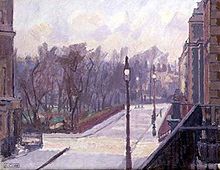
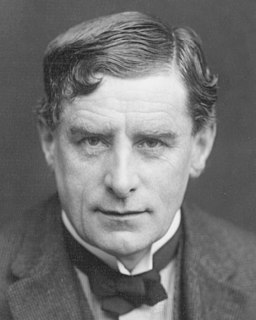
Walter Richard Sickert was a German-born British painter and printmaker who was a member of the Camden Town Group of Post-Impressionist artists in early 20th-century London. He was an important influence on distinctively British styles of avant-garde art in the mid- and late 20th century.
Charles Isaac Ginner was a British painter of landscape and urban subjects. Born in the south of France at Cannes, of British parents, in 1910 he settled in London, where he was an associate of Spencer Gore and Harold Gilman and a key member of the Camden Town Group.

Spencer Frederick Gore was a British painter of landscapes, music-hall scenes and interiors, usually with single figures. He was the first president of the Camden Town Group, and was influenced by the Post-Impressionists.

Lucien Pissarro was a landscape painter, printmaker, wood engraver and designer and printer of fine books. His landscape paintings employ techniques of Impressionism and Neo-Impressionism, but he also exhibited with Les XX. Apart from his landscapes he painted a few still lifes and family portraits. Until 1890 he worked in France, but thereafter was based in Britain.
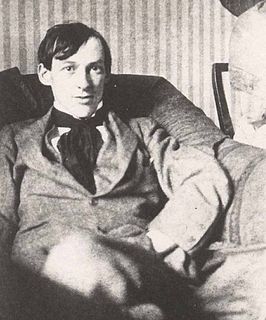
James Dickson Innes was a British painter, mainly of mountain landscapes but occasionally of figure subjects. He worked in both oils and watercolours.
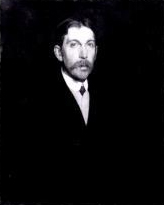
Francis Vane Phipson Rutter was a British art critic, curator and activist.
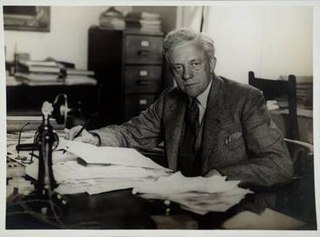
James Bolivar Manson was an artist and worked at the Tate gallery for 25 years, including serving as its director from 1930 to 1938. In the Tate's own evaluation he was the "least successful" of their directors. His time there was frustrated by his stymied ambition as a painter and he declined into alcoholism, culminating in a drunken outburst at an official dinner in Paris. Although his art policies were more advanced than previously at the Tate and embraced Impressionism, he stopped short of accepting newer artistic movements like Surrealism and German Expressionism, thus earning the scorn of critics such as Douglas Cooper. He retired on the grounds of ill health and resumed his career as a flower painter until his death.

Harold John Wilde Gilman was a British painter of interiors, portraits and landscapes, and a founder-member of the Camden Town Group.
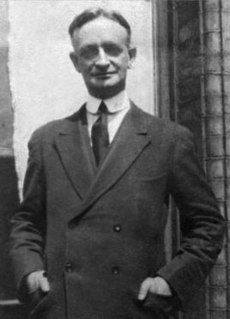
Malcolm Cyril Drummond was an English painter and printmaker, noted for his paintings of urban scenes and interiors. Influenced by the Post-Impressionists and Walter Sickert, he was a member of the Camden Town Group and the London Group.

Robert Polhill Bevan was a British painter, draughtsman and lithographer. He was a founding member of the Camden Town Group, the London Group, and the Cumberland Market Group.

The Cumberland Market Group was a short-lived artistic grouping in early twentieth century London. The group met in the studio of Robert Bevan in Cumberland Market, the old hay and straw market off Albany Street, and held one exhibition.
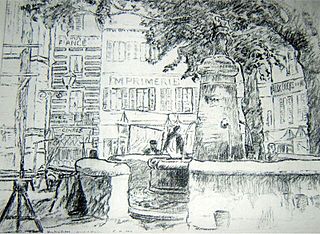
John Doman Turner was a deaf British painter and member of the Camden Town Group.

The Camden Town Murder is a title given to a group of four paintings by Walter Sickert painted in 1908. The paintings have specific titles, such as the problem picture What Shall We Do for the Rent or What Shall We Do to Pay the Rent.
Richard Shone is a British art historian and art critic specializing in British modern art, and from 2003–15 was the editor of The Burlington Magazine.
Marjorie Sherlock (1897-1973) was a British painter and etcher. Three books of her etchings were published between 1925 and 1932. Her painting Liverpool Street Station, now in the Government Art Collection, was first shown at the Royal Academy in 1917 and in 1987 was at 10 Downing Street when Margaret Thatcher was Prime Minister of the United Kingdom.
The Fitzroy Street Group was an organisation created to promote and support artists. It was established in 1907 by Walter Sickert and merged in 1913 with the Camden Town Group to form the London Group.
Walter John Bayes was an English painter and illustrator who was a founder member of both the Camden Town Group and the London Group and also a renowned art teacher and critic.
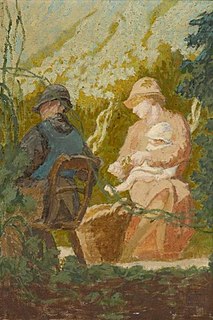
Thérèse Lessore was an English artist who worked in oil and watercolour. She was a founder member of the London Group, and the third wife of Walter Sickert.
Mary Godwin (1887–1960) was a British oil painter, water colourist and etcher, who often chose landscapes, interiors, and figures as subjects. She studied at the Women’s Department of King’s College with John Byam Shaw, and at Westminster Technical Institute with Walter Sickert and Harold Gilman. She was influenced by the Camden Town Group, and joined its successor, The London Group (LG) in 1914.